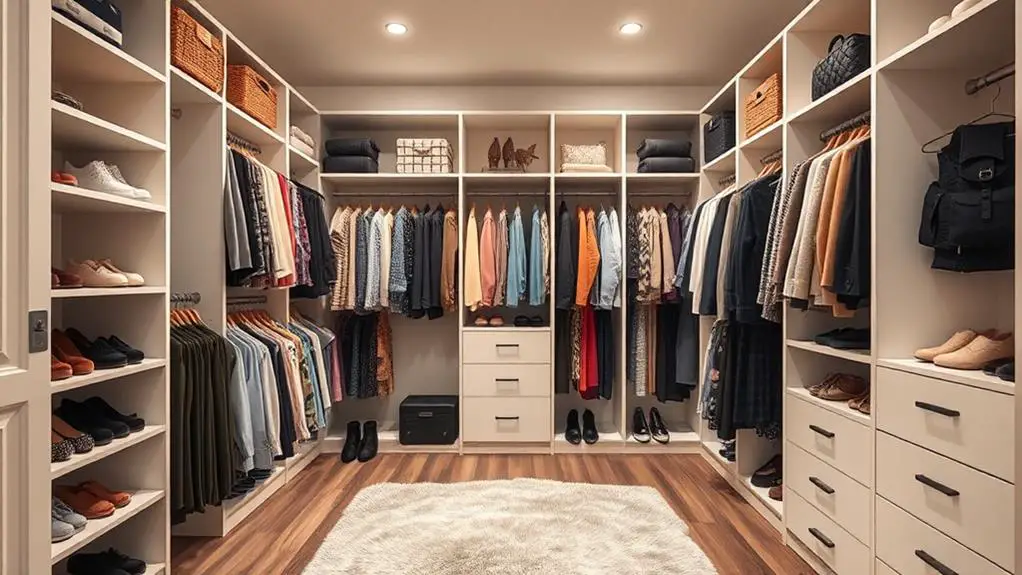Organizing your home office can greatly boost your productivity. Start by evaluating your space and creating distinct zones for different tasks. Declutter regularly to maintain a minimalist environment that enhances focus. Utilize vertical storage to maximize wall space and keep essentials within reach. Implement a solid filing system and manage your cables for a cleaner look. Consider multi-functional furniture to save space and improve functionality. Finally, set up a calendar system to keep track of tasks and appointments. These strategies will foster an efficient workspace, ensuring you stay on track to achieve your goals. Explore more tips to enhance your home office!
Summary
- Assess your space by creating distinct zones for different tasks to enhance productivity and minimize distractions.
- Regularly declutter your workspace by adopting a minimalist approach and designating spaces for essential supplies.
- Utilize vertical storage solutions, like wall-mounted organizers and pegboards, to maximize space and keep items easily accessible.
- Invest in ergonomic furniture to support posture and comfort while working, ensuring a functional and aesthetically pleasing environment.
- Personalize your workspace with inspiring colors, art, and plants to create a motivating atmosphere that enhances creativity and focus.
Assess Your Space
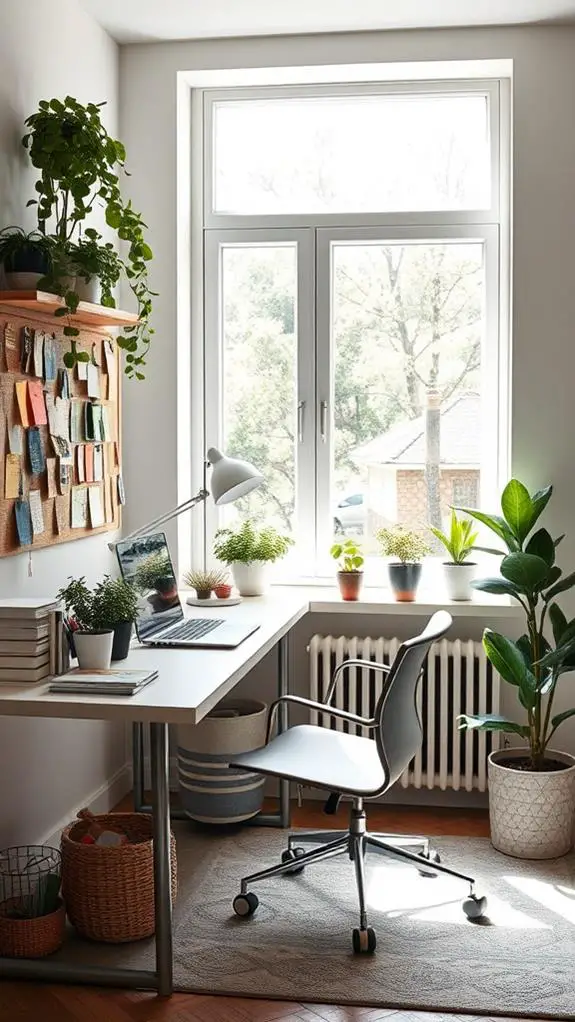
When it comes to organizing your home office, evaluating your space is an essential first step. Start with a thorough space evaluation. Measure your room to determine how much area you have available for furniture and equipment. Consider the natural light source and how it can enhance your productivity.
Next, think about layout considerations. Position your desk for ideal ergonomics and functionality, ensuring you have easy access to essential items. If you work with others, think about how they'll fit into the overall design.
Don't forget to create zones for different tasks—like a reading nook or brainstorming area. By carefully evaluating your space and layout, you'll set the foundation for a more efficient and inspiring home office.
Declutter Regularly
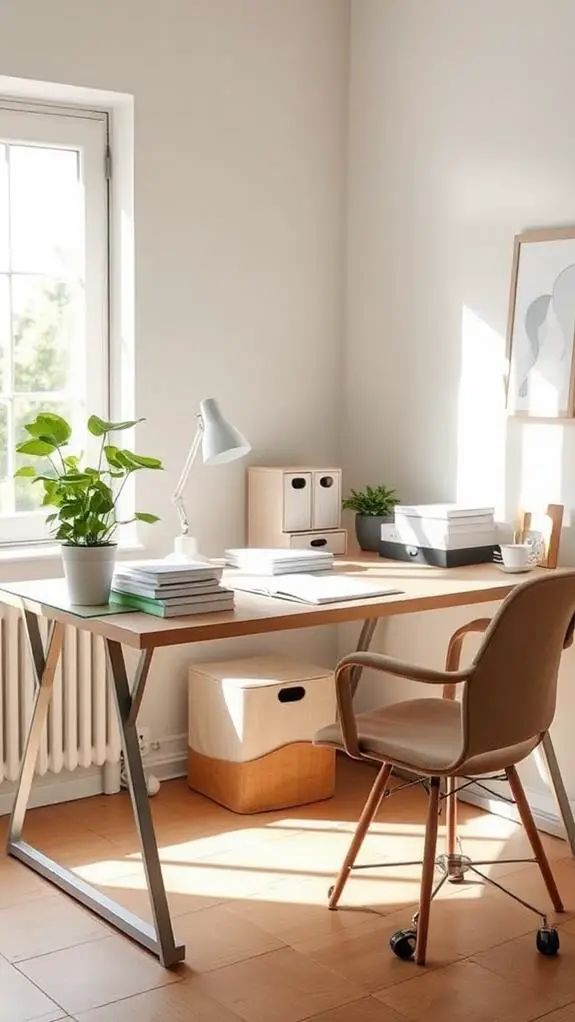
After evaluating your space, it's time to tackle the clutter that can accumulate around you. Adopting a minimalist approach helps in simplifying your environment.
Start by setting aside time for seasonal cleaning—think of it as a revitalizing reset for your home office. Assess each item: does it serve a purpose? If not, consider letting it go.
Create designated spaces for essential supplies and eliminate duplicates. Regularly revisit these areas to maintain order and prevent clutter from creeping back in.
This proactive strategy not only keeps your workspace tidy but also enhances your productivity and creativity. Embrace the idea that less truly is more, and watch your home office transform into a more functional and inspiring environment.
Use Vertical Storage
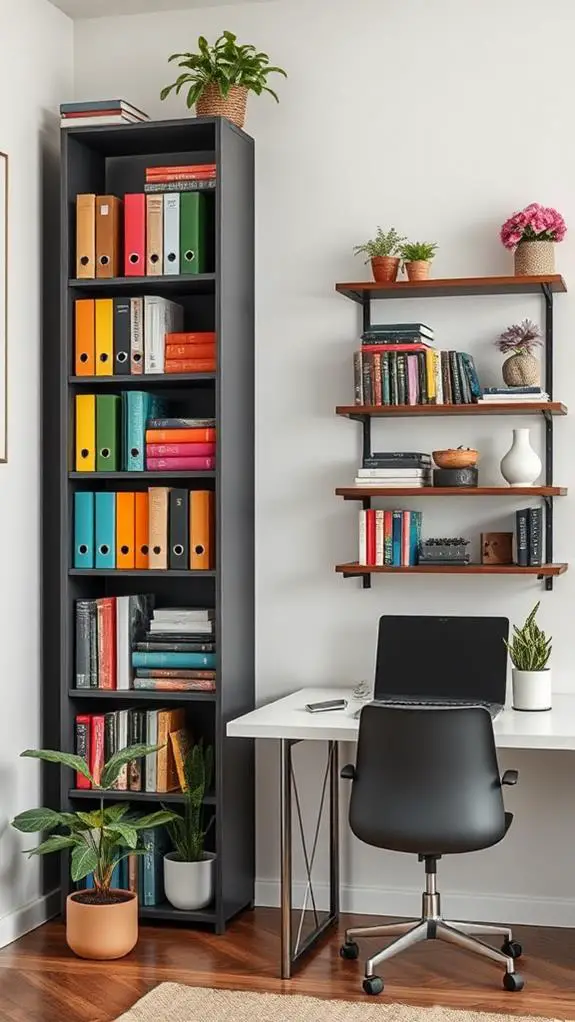
To create a more organized home office, start by maximizing your wall space.
Utilizing shelving units not only keeps your essentials within reach but also frees up valuable desk space.
Maximize Wall Space
Maximizing wall space is a smart strategy for creating an organized home office. Start by installing wall-mounted organizers to keep essentials within reach.
Use pegboard ideas for a versatile display of tools and supplies, allowing easy customization. Consider magnetic boards for task reminders and quick notes, while incorporating wall art and inspirational quotes to boost motivation.
Incorporate creative displays like photo collages or plants placement to bring life to your workspace. Choose color schemes that inspire and energize you, enhancing your productivity.
Utilize Shelving Units
When it comes to organizing your home office, utilizing shelving units can make a significant difference. Choose from various shelving styles that suit your aesthetic, whether it's minimalist design or themed decor.
Implement space planning by arranging adjustable shelves to fit your needs, allowing for accessible organization of books, files, and decorative storage. Use color coordination to create a visually appealing workspace while integrating shelving accessories like hidden compartments for a sleek look.
These elements not only enhance functionality but also contribute to a cohesive design. By optimizing vertical storage, you'll find that your office feels more spacious and organized, fostering creativity and productivity in your daily tasks.
Embrace the innovation of efficient shelving to elevate your work environment.
Organize Cables and Wires

Cables and wires can quickly turn your home office into a tangled mess, hindering productivity and creating distractions. To tackle this, start with effective cable management.
Use cable clips or sleeves to bundle cords together, keeping them organized and out of sight. Invest in a cable box to hide excess wiring and create a cleaner look.
Wire labeling is essential for easy identification; use tags to mark each cable according to its device. This saves time when plugging and unplugging.
Remember to route your cables strategically along walls or behind furniture to minimize clutter.
Implement a Filing System
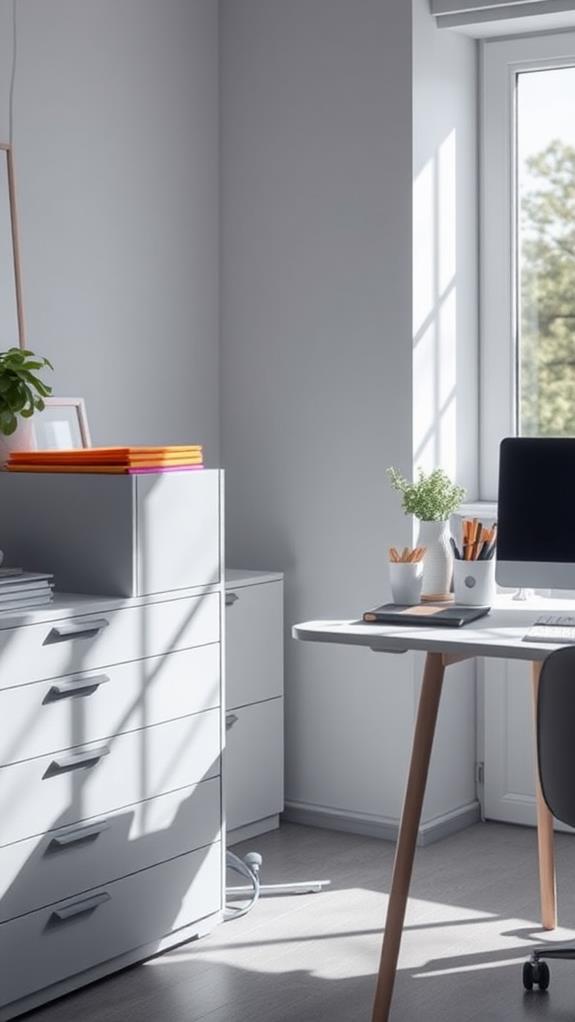
Once you've tackled cable management, it's time to focus on organizing your documents. Start by creating a folder hierarchy that reflects your projects and priorities. Use color coding for easy identification and streamline label creation for each folder.
Implement effective document retention policies to know what to keep and what to discard, and consider paperless options to minimize clutter. Digital organization is key—utilize cloud storage solutions for backups and easy retrieval methods. Ascertain you set access permissions for sensitive documents, maintaining confidentiality.
Additionally, establish backup systems to safeguard your files. By organizing your documents systematically, you'll enhance your efficiency and free up mental space for innovation in your home office.
Invest in Quality Furniture
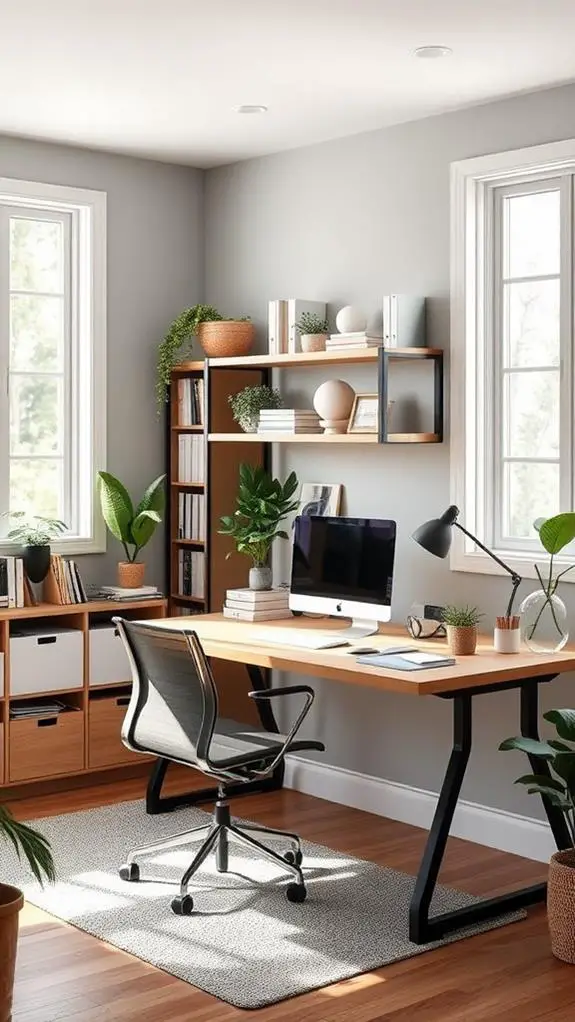
When setting up your home office, investing in quality furniture is essential for your comfort and productivity.
Choose ergonomic designs that support your posture and help reduce strain during long hours of work.
Additionally, select durable materials that can withstand daily use, ensuring your workspace remains functional and stylish for years to come.
Ergonomic Design Importance
An ergonomic design is essential for creating a comfortable and productive home office. By investing in quality furniture, you're not just enhancing aesthetics; you're prioritizing your well-being.
Focus on posture awareness by selecting chairs that support your spine and desks that suit your height. This attention to detail can greatly boost your comfort levels, reducing strain during long hours of work.
Additionally, consider adjustable features that allow you to customize your workspace for maximum efficiency. A well-designed office setup fosters better concentration and creativity, making your workday more enjoyable.
Don't underestimate the impact of ergonomics—it's an innovative approach that transforms your workspace into a hub of productivity and comfort. Make these choices, and watch your performance soar.
Durable Material Selection
Choosing the right materials for your home office furniture can greatly impact both durability and overall satisfaction. Focus on sustainable materials that not only enhance aesthetic appeal but also minimize environmental impact.
Conduct a thorough cost evaluation to confirm you're investing in quality without overspending. Look for material durability that withstands daily use, and consider texture variety to create an inviting workspace.
Pay attention to maintenance requirements; easier-to-clean finishes can save you time. Explore various finish options and color selection to match your personal style.
Personalize Your Workspace

Often, personalizing your workspace can make a significant difference in your productivity and mood.
Start by choosing a color scheme that inspires you—calm blues or energizing yellows can set the right tone. Incorporate motivational quotes and inspirational art to keep you focused. Surround yourself with personal memorabilia and favorite books that spark joy and creativity.
Adding workspace plants not only beautifies your area but also improves air quality. Include comfort items like a soft blanket or ergonomic chair, and unique accessories that reflect your personality.
Don't forget about sound control; consider using noise-canceling headphones or soothing background music. Finally, use ambiance lighting to create a welcoming atmosphere that enhances your work experience.
Optimize Lighting Conditions
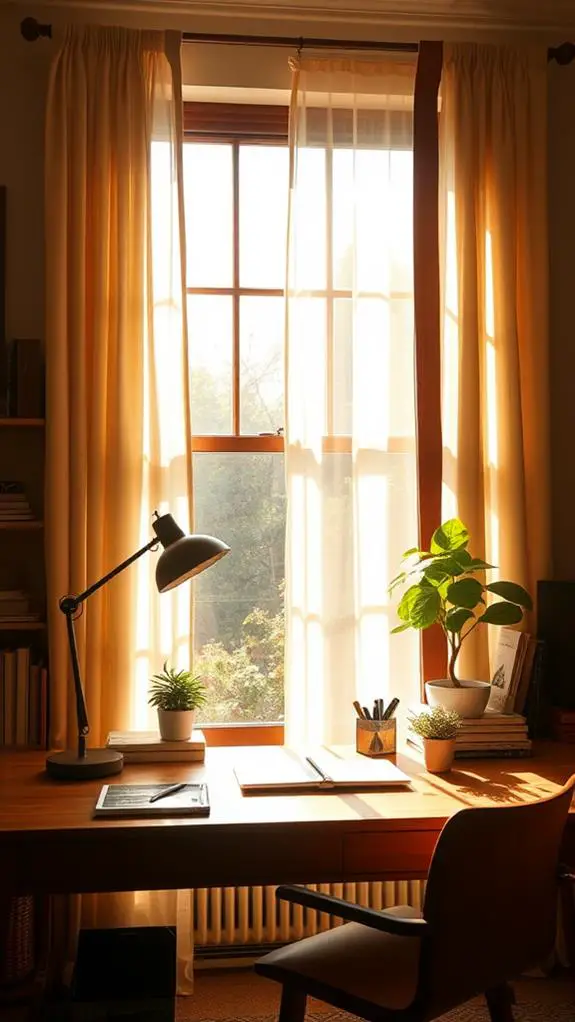
Personalizing your workspace sets the stage for productivity, but optimizing lighting conditions takes it a step further. Start by maximizing natural light; position your desk near windows to enhance energy efficiency and mood enhancement.
For tasks requiring focus, integrate task lighting with adjustable fixtures. This allows you to control light placement and tailor color temperature to your needs, creating an inviting atmosphere. Aim to reduce glare by choosing shades or diffusing materials, making your workspace comfortable and visually appealing.
Experiment with different lighting configurations to discover what enhances your concentration and creativity. By thoughtfully considering your lighting, you'll create an environment that not only looks great but also boosts your efficiency and overall well-being.
Create Zones for Tasks
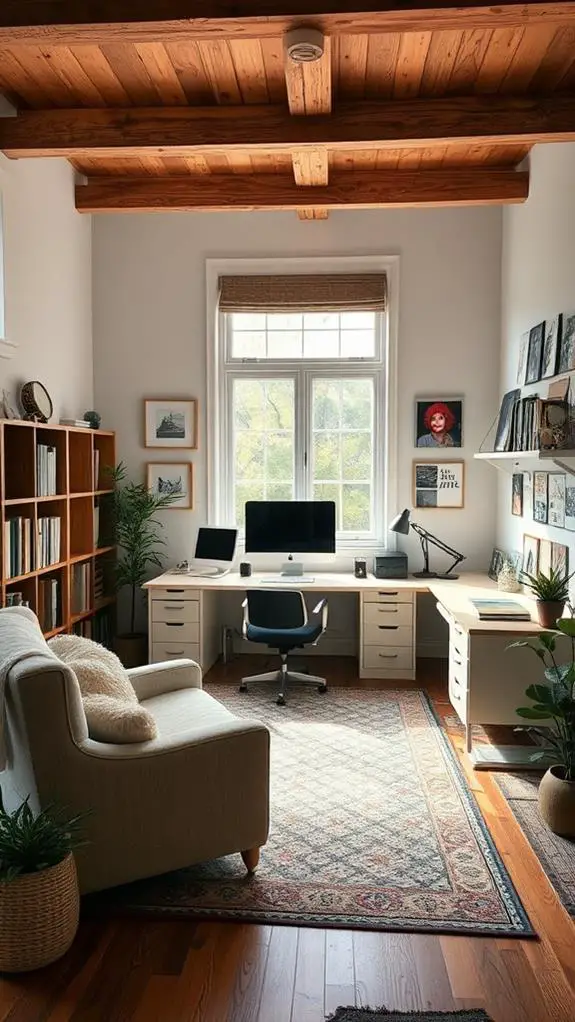
Creating distinct zones for tasks can greatly enhance your home office's functionality. By designating specific areas for different activities, you'll boost task prioritization and improve your productivity.
Start with a focused workspace, free from distractions, for deep work or critical projects. Next, carve out a collaborative zone for brainstorming and discussions, fostering a conducive workspace ambiance.
Finally, create a relaxing nook for breaks and rejuvenation. Each zone should be equipped with the necessary tools and materials to streamline your workflow.
Consider using partitions or furniture to visually separate these areas, ensuring clarity in your space. By organizing your home office into dedicated zones, you'll find it easier to switch between tasks while maintaining an innovative approach to your work environment.
Utilize Multi-Functional Items
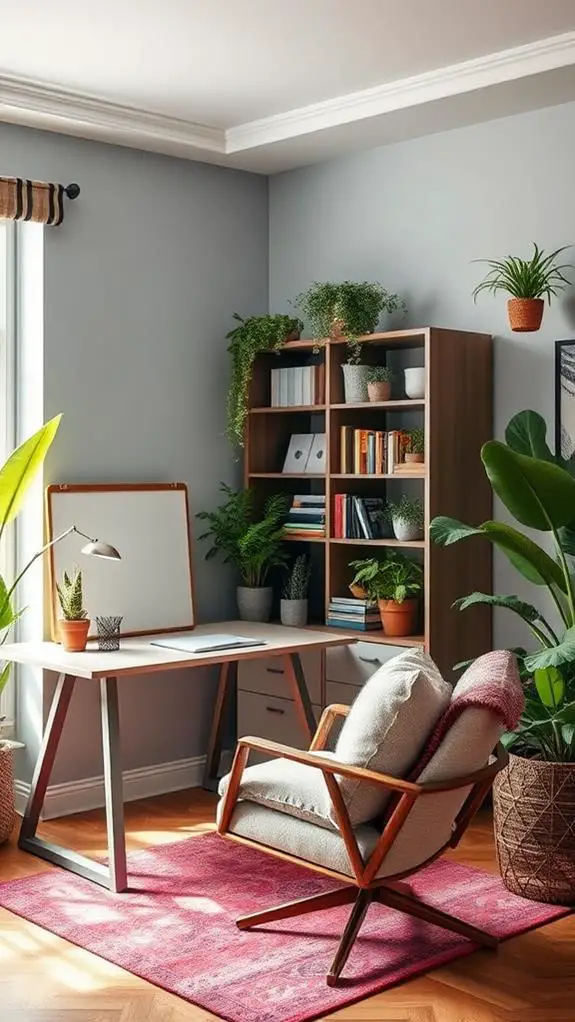
In a home office where space is often limited, utilizing multi-functional items can maximize both efficiency and organization.
Look for versatile furniture that serves multiple purposes, like a desk with built-in shelves or a coffee table that doubles as storage. These space saving solutions not only save room but also keep your workspace clutter-free.
Consider a foldable chair that can be tucked away when not in use or a wall-mounted desk that frees up floor space.
Invest in organizers that can hold office supplies and documents while also acting as decorative elements.
Set Up a Calendar System

To keep your home office organized, setting up a calendar system is essential.
First, choose a calendar type that fits your style, whether it's paper or digital.
Next, integrate digital tools for reminders and updates, and establish regular times to review and adjust your schedule.
Choose Calendar Type
Selecting the right calendar type can considerably enhance your home office organization. You've got options like digital calendars and paper planners, each offering unique benefits.
Digital calendars, especially calendar apps, provide features like reminder systems, shared calendars, and goal tracking, making event scheduling seamless. On the other hand, paper planners and wall calendars give you a tactile way to visualize your tasks and deadlines.
Monthly planners can help you break down larger projects into manageable steps. Consider incorporating color coding to differentiate between personal and professional commitments.
Ultimately, choose a calendar type that aligns with your workflow and keeps you motivated. Finding the right fit will streamline your tasks and elevate your productivity.
Integrate Digital Tools
A well-structured calendar system is essential for maximizing efficiency in your home office. Start by integrating productivity apps that sync with your cloud storage, enabling you to access digital notes and schedules from anywhere.
Use project management tools to assign tasks and deadlines, streamlining your workflow. Incorporate time tracking features to monitor your productivity and adjust as needed.
Leverage collaboration tools for seamless communication during virtual meetings, ensuring everyone stays aligned. Explore task automation to reduce manual entry, freeing up your time for strategic planning.
Prioritize software integration to connect various online resources, enhancing your overall system. By strategically integrating these digital tools, you'll create a dynamic and efficient calendar system that supports your professional goals.
Establish Regular Updates
Regular updates are vital for maintaining an effective calendar system in your home office. To optimize team collaboration, set a recurring schedule for updating your calendar. This guarantees everyone's on the same page regarding project timelines and deadlines.
Use digital tools to automate reminders and sync calendars across devices, making it easier to keep track of changes in real-time.
Create a dedicated space in your calendar for team meetings and project milestones, allowing for quick access to important information. Encourage your team to contribute by marking their own deadlines and updates.
Maintain a Routine
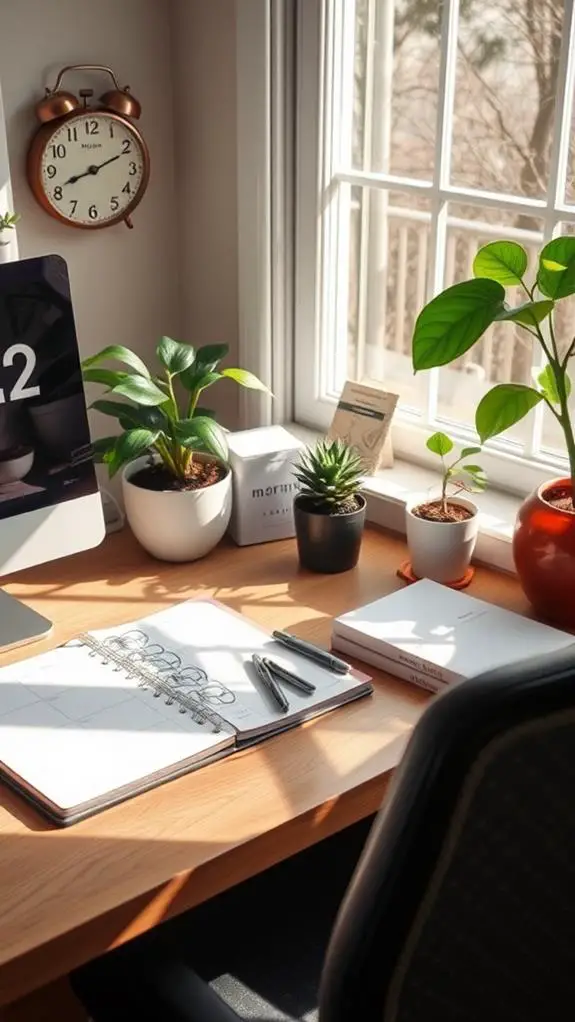
To achieve productivity in your home office, establishing a consistent routine is essential. Start your day with morning rituals that set a positive tone. Incorporate goal setting to clarify your objectives and boost motivation.
Use time management techniques to break your day into manageable segments, including dedicated work periods and break intervals to recharge. Implement productivity hacks, like task prioritization, to focus on what matters most.
Don't forget to integrate mindfulness practices during breaks to enhance your work life balance. By maintaining a structured routine, you'll not only improve efficiency but also cultivate a workspace that fosters innovation.
Stick to your routine, and watch your productivity soar as you create an environment that supports your professional success.
FAQs
What Color Schemes Are Best for a Home Office Environment?
When choosing color schemes for your workspace, consider color psychology to enhance your productivity.
Cool colors like blue and green create a calming atmosphere, while warm tones like yellow and orange can energize you.
For a modern aesthetic, pair neutrals with pops of color.
Think about how these hues impact your mood and creativity.
Ultimately, a cohesive palette can transform your workspace aesthetics, making it an inspiring place to work and innovate.
How Can I Minimize Distractions While Working From Home?
To minimize distractions while working from home, prioritize noise reduction techniques. Use noise-canceling headphones or play soft background music to create a focused atmosphere.
Implement focus techniques like the Pomodoro Technique, working in short bursts with breaks. Designate a specific workspace to mentally separate work from home life.
Keep your workspace clutter-free and limit notifications on your devices. Establish a routine that helps you stay on track and enhances productivity.
What Plants Are Suitable for a Home Office?
When considering plants for your home office, think about air purifying options that thrive in low light.
Snake plants and pothos are excellent choices; they're resilient and help cleanse the air.
Peace lilies also offer beautiful blooms and effective air purification.
These plants not only enhance your workspace's aesthetics but also boost your mood and productivity.
Incorporating greenery can transform your environment into a more innovative and revitalizing area for work.
How Do I Choose the Right Chair for Comfort?
Choosing the right chair for comfort involves focusing on ergonomic features and seat materials.
Look for chairs that support your spine's natural curve, reducing strain during long hours.
Opt for breathable materials like mesh or high-density foam for ideal comfort.
Adjustable seat height and armrests are also essential for personalized support.
Test different options to find what feels best for you, ensuring you can maintain focus and productivity throughout your day.
What Are Some Budget-Friendly Organizing Solutions for a Home Office?
If you're looking for budget-friendly organizing solutions, consider DIY storage options like repurposing old boxes or containers.
These can help you keep your essentials within reach while adding a personal touch.
For decluttering tips, start by sorting items into keep, donate, or discard piles.
Use vertical space with shelves to maximize storage.
Conclusion
By organizing your home office with these strategies, you'll create a more efficient and enjoyable workspace. Regularly assess and declutter your area, utilize vertical storage, and keep your cables tidy. Implement a solid filing system and designate task zones to boost productivity. Don't forget to use multi-functional items and set up a calendar system to stay on track. Maintaining a routine will help you stay focused and make your home office a place you love to work in.

